Physical Address
304 North Cardinal St.
Dorchester Center, MA 02124
The author wishes to acknowledge the contribution of John A. Herring for his work in the previous edition version of this chapter.
During a period of rapid growth in adolescence, weakening of the upper femoral physis and shearing stress from excessive body weight may cause the femoral capital epiphysis to displace from its normal position relative to the femoral neck. Although this disorder is termed slipped capital (or upper ) femoral epiphysis (SCFE), this terminology is technically incorrect. The femoral epiphysis maintains its normal relationship within the acetabulum, and it is the femoral neck and shaft that displace relative to the femoral epiphysis and the acetabulum. The usual deformity consists of an upward and anterior movement of the femoral neck on the capital epiphysis. The epiphysis “displaces” primarily posteriorly relative to the femoral neck.
This chapter adopts the common perspective; that is, to describe the deformity as if the capital femoral epiphysis were displaced relative to the femoral neck. Thus, we refer to “posterior displacement” of the femoral epiphysis (as occurs in the most common clinical situation) throughout this chapter. Occasionally the slip is in a different direction, with the femoral epiphysis “displacing” either forward (anteriorly) , or laterally (into a valgus position) , , relative to the femoral neck.
A slipped epiphysis may occur gradually, acutely with few prodromal symptoms, or acutely after an extended period of milder symptoms. Involvement of the hips may be unilateral or bilateral; involvement of the second hip may develop simultaneously or subsequently. The great majority of affected children do not have a demonstrable endocrine abnormality, even when their body habitus might suggest otherwise; some patients with SCFE do, however, have an important associated endocrinopathy. a
References , , , , , , , , , , , , , , , , , , , , , , , , , , , , , , , .
The incidence of SCFE varies according to race, sex, and geographic location. b
References , , , , , , , , , , , , , , , , , , , , , , , , , , , , , , , .
The incidence is estimated to be approximately 2 per 100,000 population, but this varies from less than 1 to more than 7 per 100,000, depending on race and geographic area. In the United States, there appears to be a greater risk for development of slipped epiphysis in black men and in adolescents residing in the eastern states.
There is a definite predilection for males to be affected more often than females, and for the left hip to be affected more often than the right. , The predilection for more frequent involvement of the left hip than the right also appears to be decreasing. , , , , Seasonal variations in the presentation of patients with slipped epiphysis have been identified to some extent, , , , , with an increased frequency of onset of symptoms reported in the summer months in northern latitudes and in the winter months in southern latitudes. , Urban-rural gradients are not reported to be striking, but a tendency has been noted for rural children to be affected more frequently than urban children. , There are reports of slips developing in multiple members of individual families, , but this is uncommon, and in general there does not appear to be a familial predilection for SCFE.
Race is a factor in the propensity for the development of slipped epiphysis, but whether it is also a factor in the risk for development of one of the associated complications of the condition (avascular necrosis [AVN] or chondrolysis), either spontaneously or as a complication of treatment, is unclear. An analysis of 1993 hips with slipped epiphysis reported by 33 centers on 6 continents estimated that Polynesian children had the highest prevalence of slipped epiphysis (a fourfold increase relative to whites) and Indo-Mediterranean children the lowest (a prevalence only 10% that of whites). There also was an approximately twofold greater prevalence of slipped epiphysis in blacks than in whites, and a prevalence in Hispanic children comparable with that in whites. There has also been a question as to whether the complications of AVN or chondrolysis are more frequent in black children than in nonblack children. A propensity for the development of chondrolysis in black children, particularly girls, has been suggested in a number of studies of children treated in a variety of ways for different manifestations of slipped epiphysis. , , , , However, more recent studies have specifically not identified a higher rate of either complication in black patients compared with other patients. c
References , , , , , .
There is an association between obesity and SCFE. Two separate studies have documented an association between increasing weight of children and adolescents and the frequency of SCFE. In addition, both studies documented a decrease in age at the time of diagnosis for boys and girls. , A very large cohort study in Scotland evaluated children at 5 to 6 years old and then again at 11 to 12 years old. Seventy-five percent of those obese at 5 to 6 years old remained obese at 11 to 12 years old. Those with severe obesity at 5 to 6 years old had a 5.9 times greater risk of SCFE compared to those with a normal BMI. Those with severe obesity at 11 to 12 years had a 17.0 times risk of SCFE.
Slipped epiphysis typically occurs during adolescence (boys, 12–15 years of age, averaging approximately 13 years; and girls, 11–13 years of age, averaging approximately 11 years), , , , a period of maximal skeletal growth. The youngest reported patient without identifiable endocrinopathy has been a girl 5 years 9 months of age. SCFE rarely occurs in girls after menarche. The typical age when slip occurs may be within an even narrower range when affected patients are assessed by Oxford bone age of the pelvis. , When SCFE occurs in a juvenile (10 years of age and younger) or in a patient with an open physis older than 16 years of age, careful assessment for an underlying endocrinopathy should be considered. ,
Bilateral involvement of the hips has been reported to occur in 20% to 40% of patients, and approximately 50% of these have bilateral involvement at initial presentation. , In most patients the second slip occurs within 18 months after the initial presentation. Younger patients (<12 years of age) and those with endocrine or metabolic abnormalities are at much higher risk for bilateral involvement.
SCFE can be classified temporally, according to onset of symptoms (acute, chronic, or acute-on-chronic); morphologically, as to the extent of displacement of the femoral epiphysis relative to the neck (mild, moderate, or severe), as estimated by measurement on radiographic or computed tomographic (CT) images; or functionally, according to the patient’s ability to bear weight (stable or unstable).
Currently, functional classification is most frequently used and is the most helpful for making treatment decisions and predicting complications such as AVN.
The most useful and popular current classification is that of stable and unstable slip, based on the patient’s ability to bear weight. The patient with a “stable” slip is able to bear full or partial weight, with or without crutches. The patient with an unstable slip presents like an acute femoral fracture and is unable to bear any weight on the extremity. If the patient can ambulate without weight bearing using crutches, Loder suggests that this is not to be classified as unstable. The presence of prodromal symptoms is not relevant to the classification.
One must remember that the Loder classification is a clinical classification and may underestimate the actual instability of some SCFE. Evaluating physeal disruption and stability at the time of open surgery, Ziebarth and colleagues found that the Loder classification had a sensitivity of 39% and a specificity of 76%.
For many years SCFE was classified as acute, chronic, or acute-on-chronic. An acute SCFE has been characterized as one occurring in a patient with prodromal symptoms for 3 weeks or less, and presents as a sudden, fracture-like episode occurring after usually minor trauma. The patient is in severe pain and either cannot ambulate or is able to do so only with great difficulty. Radiographs demonstrate little or no femoral neck remodeling changes typical of chronic SCFE ( Fig. 15.1A ). A traumatic Salter 1 type of fracture separation of the capital epiphysis occurs with much greater trauma and without prodromal symptoms. In these the femoral head may be dislocated out of the hip capsule and the femoral head almost invariably is avascular.
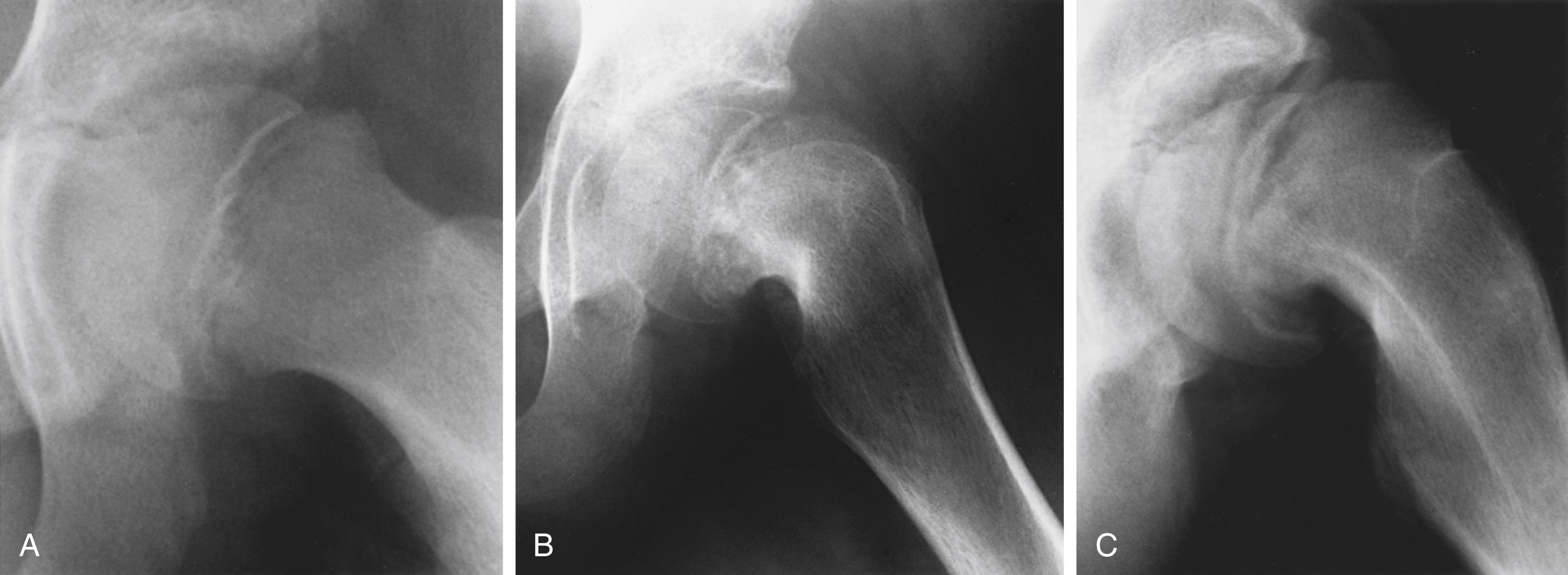
Chronic SCFE is the most frequent form of presentation. Typically, an adolescent presents with a few months’ history of vague groin pain, upper or lower thigh pain, and a limp. In an international study by Loder, 85% of 1630 children with 1993 slipped epiphyses had chronic symptoms, and 15% had acute slipped epiphysis, as defined as the child’s presenting with symptoms beginning less than 3 weeks prior. Radiographs of patients with chronic SCFE show a variable amount of posterior migration of the femoral epiphysis and remodeling of the femoral neck in the same direction (see Fig. 15.1B ). Thus, the upper end of the femur develops a “bending of the neck,” as described by Müller. The clinical symptoms, physical findings, and anteroposterior (AP) radiographic features especially may be sufficiently minor that the unwary physician fails to make the proper diagnosis.
The acute-on-chronic slipped epiphysis is one in which prodromal symptoms have been present for more than 3 weeks with a sudden exacerbation of pain and inability to walk. Radiographs show evidence of both femoral neck remodeling with epiphysis displaced beyond the remodeling point of the femoral neck (see Fig. 15.1C ).
SCFE may also be categorized by the degree of displacement of the capital femoral epiphysis on the femoral neck. Several methods for categorizing slip based on the extent of displacement exist. Southwick recommended measuring the femoral head-shaft angle on AP ( Fig. 15.2A ) or frog-leg lateral views (see Fig. 15.2B ). By this method, mild slips are ones in which the head-shaft angle differs by less than 30 degrees from the normal contralateral side. In moderate slips, the angle difference is between 30 and 60 degrees, and in severe slips the angle differs by more than 60 degrees from the contralateral normal side. When the contralateral hip is affected or not assessed, the femoral head-shaft angle of the affected hip is calculated from normal values for this angle; according to Southwick, these normal values are 145 degrees on the AP view and 10 degrees posterior on the frog-leg lateral view. Guzzanti and Falciglia and others have pointed out that, because of the three-dimensional nature of the deformity of slipped epiphysis and inconsistencies of patient positioning for frog-leg lateral radiographs, measurement of the femoral head-shaft angle on this view is subject to substantial error. Head-shaft or head-neck angles can be obtained either from true lateral radiographs or from specifically positioned, modified lateral radiographs (Billing , , , or Dunlap techniques). The head-neck angle can be determined most accurately and reproducibly on CT scans of the head and neck ( Fig. 15.3 ), , but this method is not routinely used because most patients do not undergo CT.
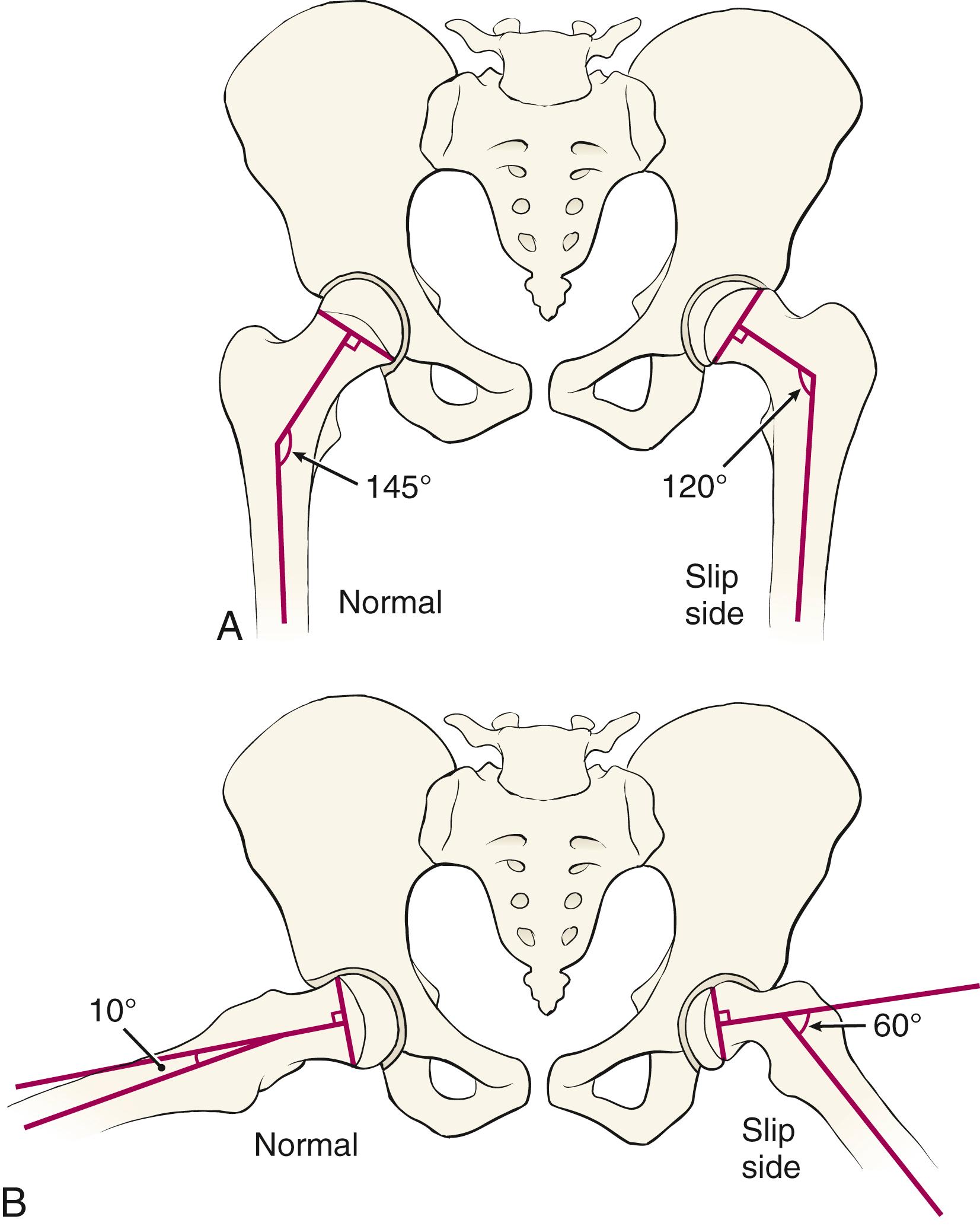
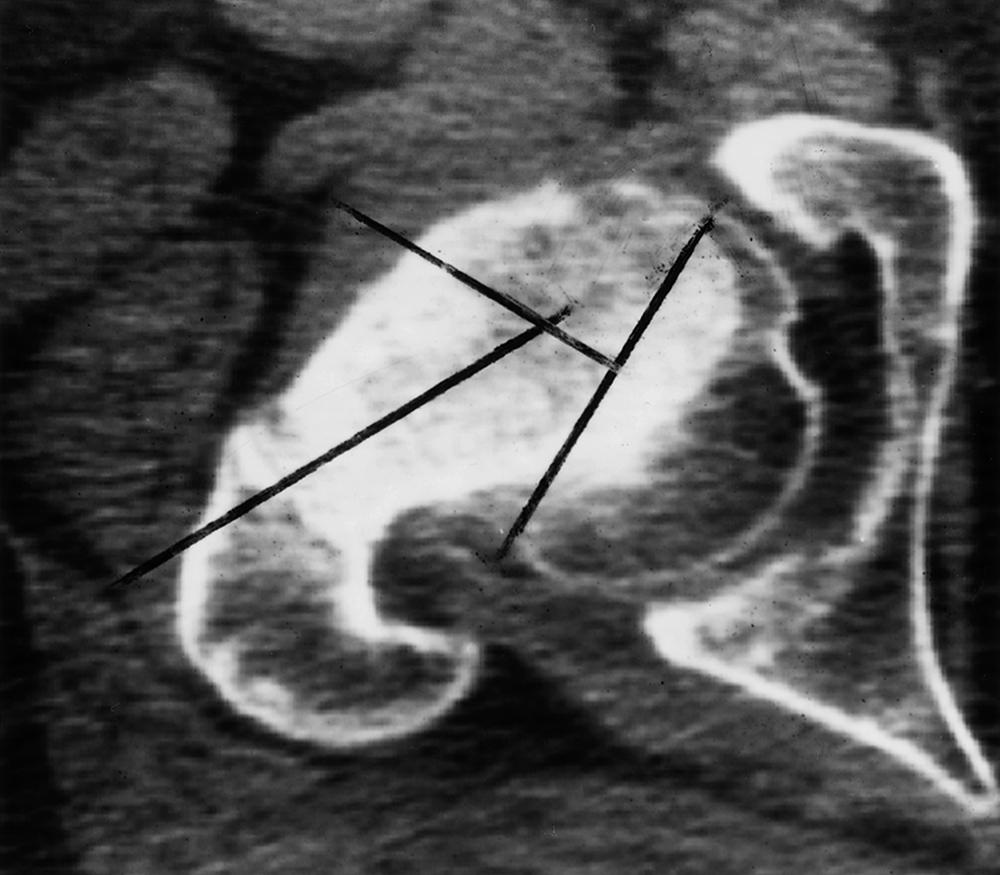
In most patients the cause of SCFE is unknown, but mechanical, endocrine, and genetic factors are thought to play a role.
A number of features of the adolescent hip in general and of patients with slipped epiphysis in particular make it likely that mechanical causes are at least partly responsible for slipped epiphysis. Three important features of the predisposed hip contribute to or may be the primary cause of slipped epiphysis: (1) thinning of the perichondral ring complex with maturation, altering the mechanical strength of the physis, periosteum, and perichondral ring; (2) relative or absolute retroversion of the femoral neck; and (3) a change in the inclination of the adolescent proximal femoral physis relative to the femoral neck and shaft. d
References , , , , , , , .
The perichondral ring complex is a fibrous band that encircles the physis at the cartilage-bone junction. Its shear strength is provided by collagen fibers that run obliquely, vertically, and circumferentially. These collagen fibers span the physis, attaching to the ossification groove on the epiphyseal side and to the subperiosteal bone on the metaphyseal side. The perichondral ring acts as a limiting membrane, giving mechanical support to the physis. The perichondral ring complex thins rapidly with increasing age and the mammillary processes (interdigitating reciprocal protrusions of bone and cartilage at the epiphyseal-metaphyseal interface) become increasingly important in providing resistance to shearing forces. Thus with skeletal maturation, the load-carrying capacity and the shear resistance of the mammillary processes increase, and the strength of the perichondral complex decreases. Shearing forces across the physis, which may be especially great in obese children, coupled with the changing relationship between the resistance provided by the perichondral and mammillary structures, set the stage for slips to occur.
Another consistent anatomic finding is a relative or absolute femoral retroversion in patients with slipped epiphysis. Analyses of femoral retroversion by CT , and direct examination of museum specimens have identified retroversion in patients with slipped epiphysis. In contradistinction, acetabular version and tibial torsion are reportedly normal in patients with slips. , It seems plausible that increased retroversion makes the proximal femoral physis more susceptible to AP shearing forces.
Measurement of the slope of the proximal femoral physis on AP radiographs in children with and without unilateral SCFE found that patients with a slipped epiphysis had a slope averaging 11 degrees more on the affected side and nearly 5 degrees more on the unaffected side than those without a slip, suggesting that increased obliquity of the proximal femoral physis may be a factor in the development of SCFE.
SCFE has been associated with two other conditions that probably have a mechanical cause: infantile and adolescent Blount disease. , SCFE has also been reported in patients with peroneal spastic flatfoot and Legg-Calvé-Perthes disease. The exact causal relationship to these conditions is unknown.
The stereotype of an obese, hypogonadal male (the so-called adiposogenital syndrome) presenting with chronic bilateral slipped epiphyses has long stimulated the thought that some alteration in the balance of thyroid, growth, and sex hormones was the cause of slipped epiphysis. , Evidence of hormonal alteration in most patients, even those fitting this image, is lacking. , , , , An “age-weight” test has been described to determine the likelihood of atypical SCFE and the need for further diagnostic investigation. Patients younger than 10 years of age or older than 16 years were found to be four times more likely to have an atypical SCFE. For patients of the same age, those below the 50th percentile for weight were more than eight times more likely to have an atypical SCFE. Some patients do have an endocrine abnormality, the most common being hypothyroidism (slips can occur either before or during replacement therapy), growth hormone deficiency (slips usually occur during or after replacement therapy), and chronic renal failure (due to uncontrolled secondary hyperparathyroidism).
An endocrinologic cause for slipped epiphysis has long been suspected, based on the common association of this condition with obesity and, at least in boys, hypogonadal features (the so-called adiposogenital syndrome), and the fact that the condition most frequently manifests during the adolescent growth spurt. Furthermore, slips are known to occur in patients with known endocrine abnormalities, most commonly hypothyroidism (treated or not), e
References , , , , , , , , .
abnormalities treated by growth hormone administration, f
References , , , , , , .
and chronic renal failure. g
References , , , , , .
SCFE has also occurred in patients with prior pelvic irradiation, h
References , , , , , .
Rubinstein-Taybi syndrome, Klinefelter syndrome, and rarer endocrinopathies, such as primary hyperparathyroidism , , and panhypopituitarism associated with intracranial tumors. , One study showed that slips developed in hypothyroid patients both before and during replacement therapy, whereas in growth hormone-deficient patients a slipped epiphysis developed during or after growth hormone replacement therapy. Sixty-one percent of the patients with these disorders had or developed bilateral slips. Thus prophylactic pinning of the normal contralateral side must be strongly considered in endocrinopathy-associated slipped epiphysis. Blethen and Rundle found that the risk for development of SCFE in patients receiving growth hormone treatment for idiopathic short stature was approximately the same as that reported in the general population but was significantly higher in patients with growth hormone deficiency, Turner syndrome, or chronic renal insufficiency (91 per 100,000 in this study).
Slipped epiphysis associated with chronic renal insufficiency is thought to be secondary to uncontrolled secondary hyperparathyroidism. Loder and Hensinger noted that 95% of slips associated with chronic renal failure were bilateral, and almost all of these presented simultaneously. Approximately 50% of cases were treated conservatively by medical management of the renal disease, including renal transplantation, whereas the other 50% required surgery for the slip. Because there was a relatively high incidence of slip progression after surgical treatment (12 of 21 hips), monitoring of the hips must continue until skeletal maturity in these patients.
To summarize, most patients with SCFE prove to be normal by current endocrinologic evaluations, however, and screening for abnormalities is not warranted unless clinical suspicion exists based on the presence of signs and symptoms other than obesity. In these patients, who constitute the vast majority of those with slips, it seems plausible that mechanical factors, including femoral retroversion, thinning of the perichondral ring complex with adolescent maturation, obesity, and some as yet unidentified hormonal or biochemical factor that results in weakening of the proximal femoral physis combine to make the proximal femoral physis more susceptible to shearing forces, which in turn cause the actual displacement of the physis.
Grossly, with gradual slipping of the capital epiphysis in the typical posterior position, the periosteum is stripped from the anterior and inferior surface of the femoral neck. The area between the original femoral neck and the posterior periosteum fills with callus, which ossifies and becomes progressively more dense. The anterosuperior portion of the neck metaphysis forms a “hump” or ridge of bone that can impinge on the rim of the acetabulum. Frequently, this ridge will remodel, with the anterior portion of the neck contouring into a smoother surface. In cases of acute slipping, the periosteum is torn anteriorly, and hemarthrosis is present.
The microscopic changes seen in the physes affected by slipped epiphysis have been described in a number of reports ( Fig. 15.4 ). , , , Howorth in 1949 provided a comprehensive review of the histopathologic findings in 169 hips with slipped epiphysis that had been treated by open bone peg epiphysiodesis, open reductions, or femoral neck wedge osteotomies. He described a “preslip” stage characterized by widening of the physis both histologically and radiographically without actual displacement of the capital epiphysis. In this stage, the synovial membrane is edematous, as are the capsule and periosteum, to a more limited extent. The resting zone of the physis is usually normal in appearance microscopically but accounts for a smaller percentage of the total thickness of the physis because of the relative increase in the thickness of the proliferative and hypertrophic zones. Both the proliferative and the hypertrophic zones demonstrate an overall decreased number of chondrocytes with an excess amount of matrix tissue. The columnar alignment of chondrocytes is disrupted, and the cells tend to be organized into clumps. The actual displacement of the epiphysis on the femoral neck occurs largely through the hypertrophic zone of the physis, but some of the displacement also occurs through the zone of provisional calcification. Electron microscopic evaluation of biopsies revealed that collagen fibers in the matrix of the hypertrophic and proliferative zones were generally fewer, variable in size, and irregularly organized. There were focal areas with increased collagen fibers, and chondrocyte degeneration and death throughout the proliferative and hypertrophic zones. Significant changes were found in the chondrocytes themselves only in the hypertrophic zone.
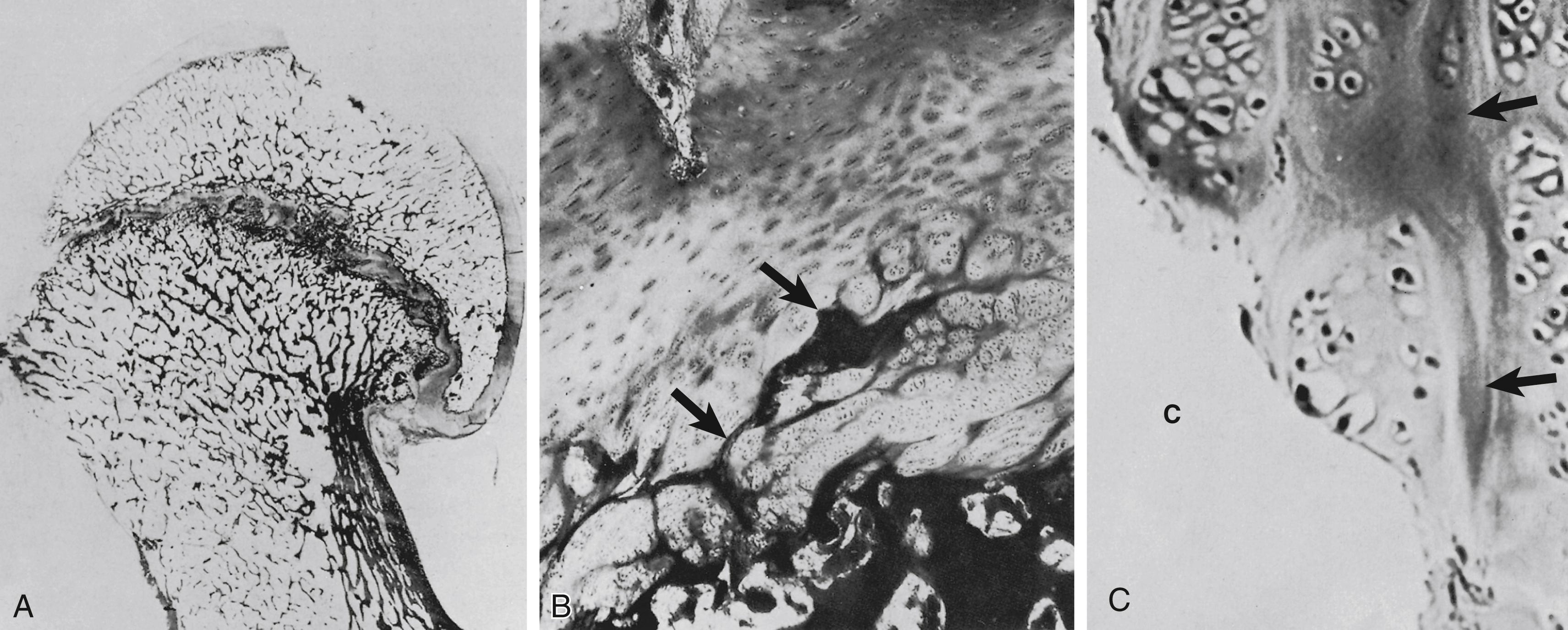
The symptoms and physical findings vary according to whether the symptoms are chronic, acute-on-chronic, or acute; whether the slip is stable or unstable; with the severity of the resultant deformity; and with the coexistence of the complications of AVN or chondrolysis. Because approximately 20% of patients have evidence of contralateral slip on initial presentation, the contralateral hip must always be carefully assessed both clinically and radiographically.
In stable, chronic SCFE, the presenting complaint is usually pain in the region of the groin, which may be referred to the anteromedial aspect of the thigh and knee. In some patients, complaints of pain are exclusively or predominantly localized to the lower thigh or knee; this localization results in the continued problem of a delayed or incorrect diagnosis. ,
Primary care physicians and orthopaedists must be ever mindful of the prevalence of slipped epiphysis in the adolescent population. A high index of suspicion is critical due to the indolent nature of complaints in patients with stable slips and the propensity for complaints of pain to be localized to the distal thigh or knee. The adage that any child or adolescent who presents with complaints of pain in the knee region must first undergo careful examination of the hip, including radiography if necessary, before examination of the knee, is still true. Vague symptomatology can lead to a delay in diagnosis, which in turn can lead to poor outcomes. Schur and colleagues demonstrated no improvement in the speed of diagnosis over a 10-year period. The average time from the onset of symptoms to the time of diagnosis was 17 weeks. The time from initial evaluation to the time of diagnosis was significantly greater if the child was first evaluated by a primary care provider. Similarly, Hosseinzadeh and colleagues reported an average time of 13.4 weeks from the time of initial evaluation to diagnosis when a child was first seen by a non-orthopaedic provider.
The pain is typically described as dull and vague; it may be intermittent or continuous, and it is exacerbated by physical activity, such as running or sports. The onset of pain may be of several weeks or months in duration. The patient will have an antalgic limp, with the affected side held in a position of increased external rotation. The examining physician should not ask the patient to perform strenuous examination maneuvers, such as running, hopping on either foot, or squatting, because these maneuvers could theoretically induce acute displacement of a stable slip. Thigh atrophy may be apparent in unilateral cases; the often associated obesity may make this finding difficult to discern. Local tenderness may be elicited anteriorly over the hip joint. Examination of the arc of motion of the affected hip reveals a restriction of internal rotation, abduction, and flexion. Commonly, the examiner notes that as the affected hip is flexed, the thigh tends to rotate into progressively more external rotation, and that flexion is limited ( Fig. 15.5 ). The loss of internal rotation on examination, with complaints of pain at the limit of internal rotation, is a key finding in stable SCFE. The limitation of hip motion actually represents a change in location of a relatively preserved arc of motion rather than a loss of motion. Increased hip extension, external rotation, and adduction are usually present, with decreased flexion, internal rotation, and abduction, depending on the severity of the slip. The presence of hip flexion contracture should alert the physician to the possibility of chondrolysis. There may be shortening of the affected extremity by 1 to 2 cm. The stereotypical patient with chronic slipped epiphysis is male, obese, and hypogonadal. Other patients have a normal habitus. , ,
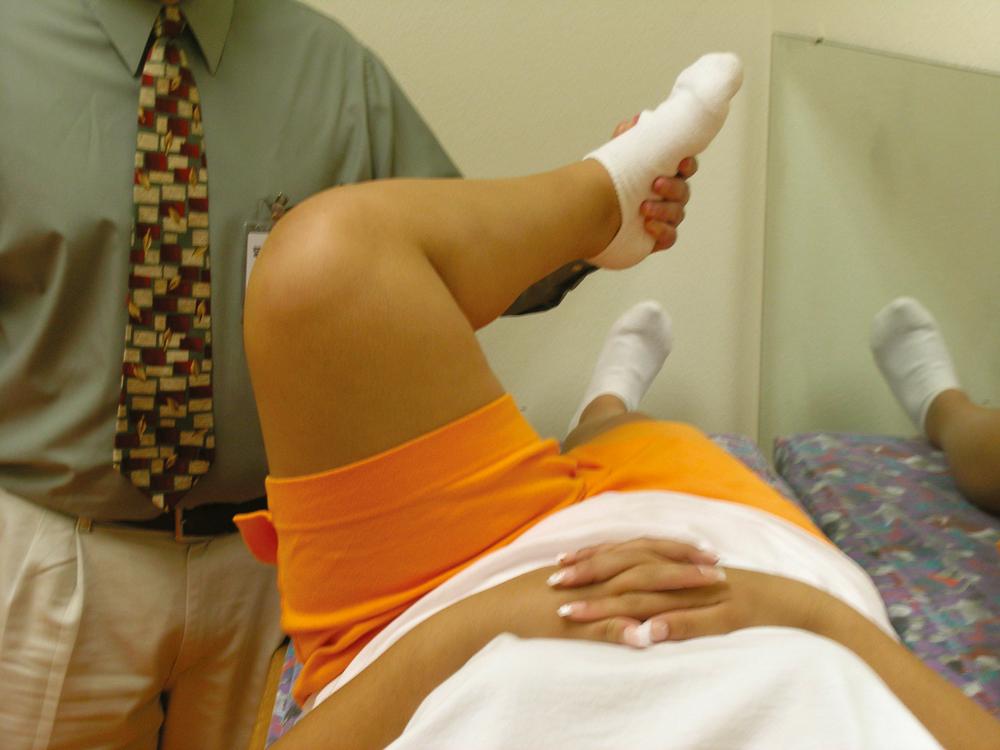
Patients presenting with unstable acute or acute-on-chronic slipped epiphysis characteristically report the sudden onset of severe, fracture-like pain in the affected hip region, usually as the result of a relatively minor fall or twisting injury. The severity of the symptoms makes the patient unable to bear weight and likely to seek prompt medical attention. Occasionally, presentation to the physician is delayed for some unfortunate reason, and the patient may have resumed weight bearing. The patient usually lies with the affected limb in external rotation and refuses to move the hip. Moderate shortening of the limb is apparent to the examiner. Severe pain results from any movement of the limb.
Patients presenting with chondrolysis complicating slipped epiphysis tend to have a history of more continuous pain and greater interference with daily activities because of the loss of hip joint range of motion. On examination, the affected hip is held in an externally rotated position at rest, with flexion contracture and global restriction of hip motion. The patient usually complains of pain throughout the arc of motion rather than just at its extremes.
Plain radiography in AP and lateral views is the primary and often the only imaging modality needed to evaluate slipped epiphysis. The earliest radiographic sign is widening and irregularity of the physis with rarefaction in its juxtaepiphyseal portion. This early stage has been termed preslip by some authors, i
References , , , , , .
because actual displacement may not be evident on the radiographs. In the earliest phase of mild slips with typical posterior displacement, the AP radiographic findings may be subtle. In the normal hip, a line drawn tangential to the superior femoral neck (Klein line) on the AP view intersects a small portion of the lateral capital epiphysis. When typical posterior displacement of the capital epiphysis has occurred, this line intersects a smaller portion of the epiphysis or not at all (Trethowan sign; Fig. 15.6 ). The “metaphyseal blanch sign,” a crescent-shaped area of increased density overlying the metaphysis adjacent to the physis, may be seen on the AP radiograph ( Fig. 15.7 ). This increased density is due to the overlapping of the femoral neck and the posteriorly displaced capital epiphysis. In the normal adolescent hip, a portion of the diaphysis of the neck inferomedially is intraarticular and overlies the posterior wall of the acetabulum, creating a dense triangular appearance. In most patients with slipped epiphysis, this dense triangle is lost as that portion of the neck becomes located lateral to the acetabulum ( Fig. 15.8 ).
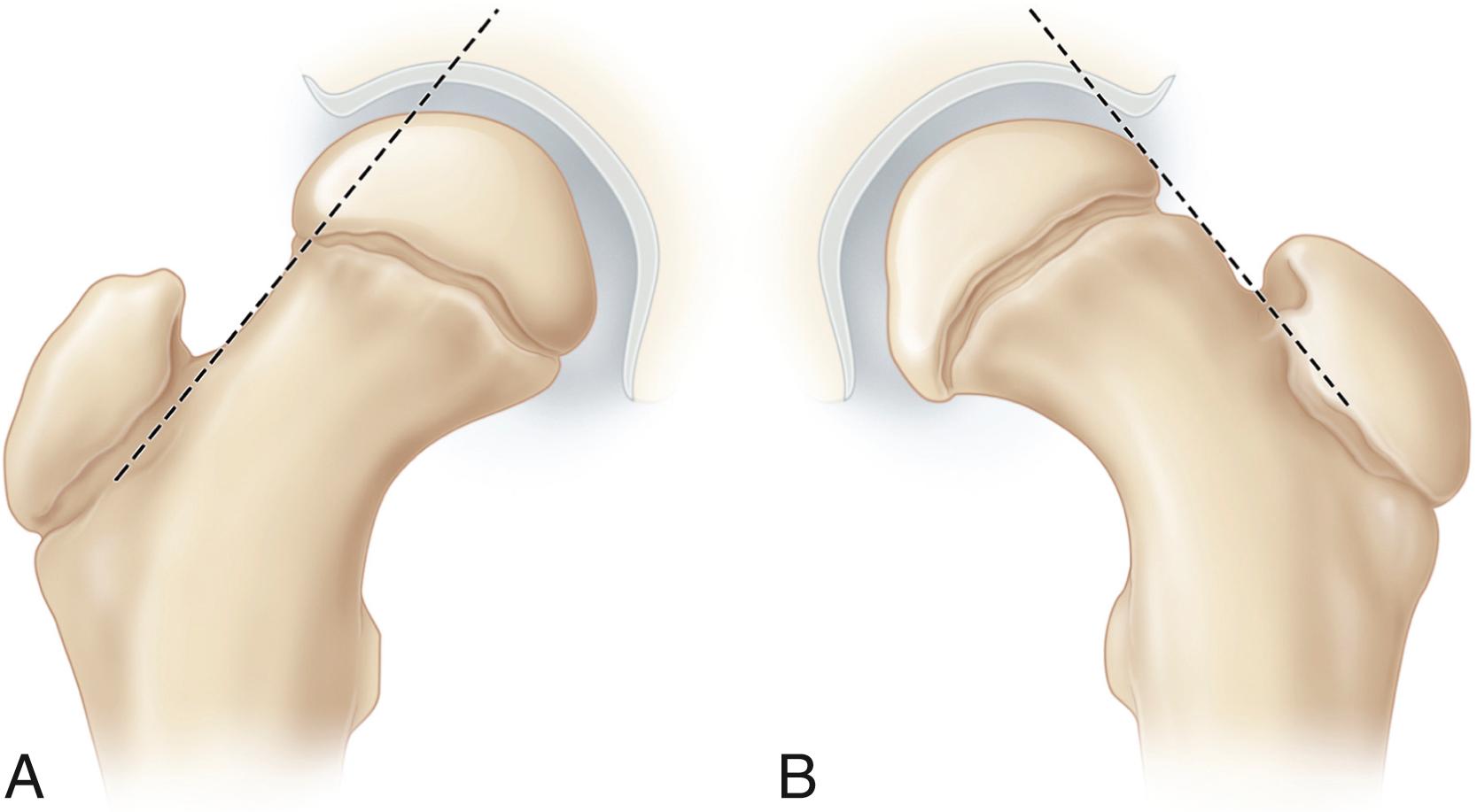

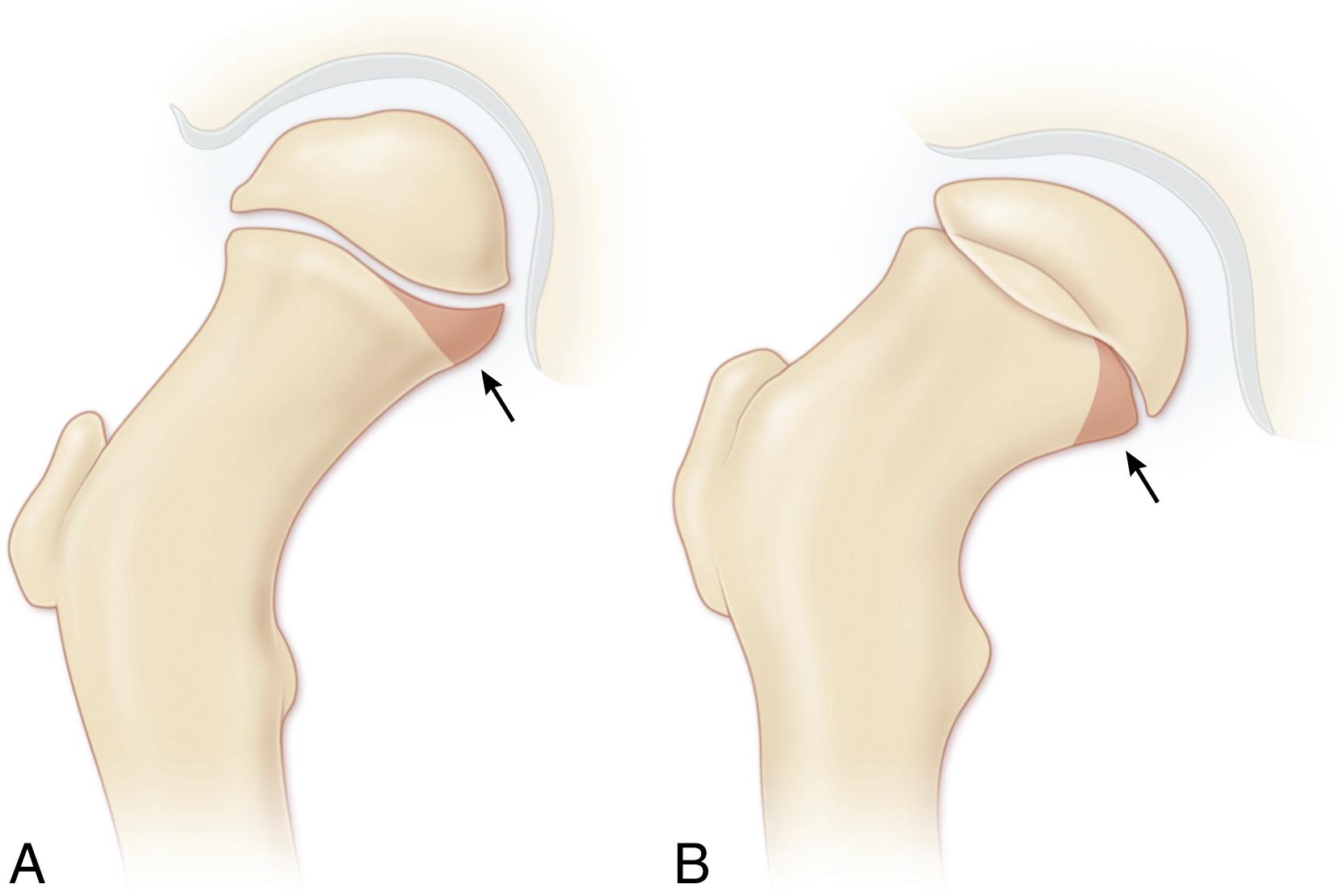
Whenever slipped epiphysis is suspected based on the patient’s history, the physical examination findings, or the presence of any subtle findings on the AP radiograph, it is essential to obtain lateral radiographs of the hip as well. The frog-leg lateral view is customarily obtained. This view has several advantages: it is easily obtained by having the patient flex and abduct the hips; soft tissue obscuring of the bony image is minimized; and both hips can be visualized on one film. This view is adequate to confirm the diagnosis of most cases of slipped epiphysis. However, variations in positioning make it an imprecise method of assessing the severity of slip. This view also is not usually adequate for assessing the possibility of penetration of the hip joint by a metallic implant. Alternative lateral radiographic views include a true lateral radiograph; the modified Dunlap lateral radiograph ; and the modified Billing lateral radiograph. , To obtain the modified Billing view, an AP view of the hip is obtained with the limb resting on a wedge in a position of 90 degrees of flexion, approximately 65 degrees of abduction, and neutral rotation.
When the slip is acute, little or no remodeling of the femoral neck is apparent on radiographs; only the displacement of the capital epiphysis on the femoral neck through the physis is seen. When the slip has been present for some time, allowing for some remodeling of the femoral neck, this remodeling appears as a bending of the femoral neck in the direction of the “slipping” capital epiphysis. Appositional new bone is present on the inferomedial surface of the neck, and the anterosuperior neck resorbs, producing a rounding or “hump” appearance. In patients with a component of acute progression after an initial period of slow displacement of the capital epiphysis with femoral neck remodeling, both radiographic features are present; that is, the femoral neck is remodeled to some extent, and the capital epiphysis is displaced beyond the margin of the femoral neck remodeling (see Fig. 15.1A and C ).
Computed tomography of the upper femur has been useful in documenting the presence of decreased upper femoral neck anteversion or true retroversion, and it is also believed to be more accurate in the measurement of the head-neck angle (similar to the head-shaft angle of Southwick as described for plain radiographs, but the angle measured is the tangent to the base of the epiphysis and the axis of the femoral neck; see Fig. 15.3 ). However, CT of the hip is not usually necessary to document or treat slipped epiphysis.
CT, however, can be useful in the management of slips. First, CT of the hip can be very helpful in demonstrating whether penetration of the hip joint by fixation devices has occurred ( Fig. 15.9 ). Pin penetration can be difficult to recognize on plain radiographs because hip stiffness due to either AVN or chondrolysis can make patient positioning difficult, or patient obesity may make visualization of the margins of the femoral head difficult. Another indication for CT is to confirm closure of the proximal femoral physis. Documentation of closure can be difficult with plain radiography but may be important in the investigation of continued or recurrent pain in a hip previously treated for slipped epiphysis. Finally, three-dimensional reconstructed CT images can be used to assess the severity of residual deformity of the upper femur, especially when reconstructive osteotomy is being considered.

Bone imaging with technetium-99 shows increased uptake in the capital femoral physis of an involved hip, decreased uptake in the presence of AVN, and increased uptake in the joint space in the presence of chondrolysis. With respect to the detection of involvement of the hip with slipped epiphysis, however, clinical examination and careful assessment of AP and good lateral radiographs usually suffice to make the proper diagnosis. If further assessment is required because of equivocal involvement after clinical assessment and plain radiography, either ultrasonography or CT is more sensitive and specific in confirming the presence of an early mild slip, or so-called preslip. Abnormally decreased uptake in the epiphysis is highly specific for the diagnosis of AVN. When chondrolysis is present, there is increased uptake of isotope on both sides of the joint on bone scintigraphy.
Ultrasonography has been used in the assessment of slipped epiphysis. , , Several authors have found that ultrasonography is useful in the detection of early slips by demonstrating joint effusion and a “step” between the femoral neck and the epiphysis created by slipping. , ,
Although early detection of SCFE has been recorded using magnetic resonance imaging (MRI), , , plain radiography, CT, or ultrasonography can usually achieve this goal more cheaply and expediently. If the results of the radiographs are negative, but the patient has symptoms, a body habitus, and a physical examination consistent with SCFE, MRI may detect physeal widening and irregularity, which are the earliest signs of SCFE. MRI is a sophisticated imaging technique highly specific for the detection of AVN. However, the presence of a stainless steel implant can seriously degrade the quality of the image and prevent an accurate diagnosis.
Patients with suspected stable SCFE should be escorted to the radiology suite, preferably in a wheelchair or on a stretcher. Patients with an unstable slip should be immobilized on a stretcher with light skin traction applied to the affected limb to minimize pain with transportation and should be provided with appropriate analgesics as soon as a plan for definitive management has been formulated. Patients with stable slips may be adequately evaluated with good AP and frog-leg lateral views of both hips. Cross-table lateral radiographs may be more accurate for assessing the presence and severity of slips but are not recommended because they are difficult to obtain if the patient is obese or in severe pain and they expose the patient’s gonads to a higher dose of radiation as compared to a frog lateral. Frog-leg lateral views are not needed and should not be attempted in patients with unstable slips. Additional manipulation of the leg results in unnecessary pain and further risk to the femoral epiphysis blood supply.
Once the diagnosis has been confirmed and an open capital femoral physis noted, the patient should be admitted to the hospital and placed on bed rest until prompt, definitive management of the SCFE is undertaken. Acute displacement of the epiphysis after diagnosis of mild chronic slip has been documented repeatedly. , This event can dramatically alter the patient’s prognosis. , , , ,
Become a Clinical Tree membership for Full access and enjoy Unlimited articles
If you are a member. Log in here